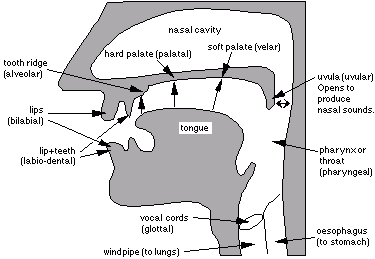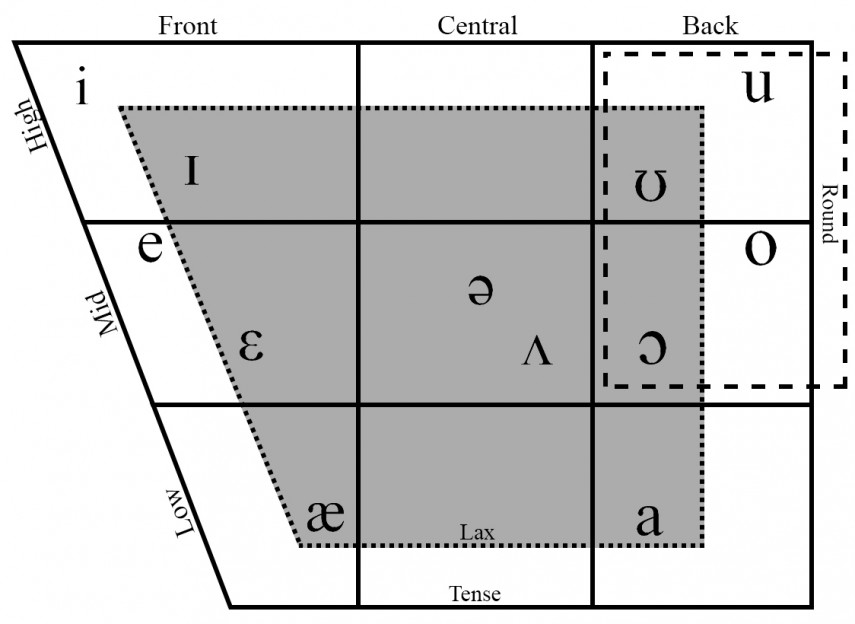
A Tour of Phonology, Part 1 by Joonho K. '20
fənɛtɪks ɪz fʌn!
Part 1: Phonetics
ðɪs ɪz ʌ sɛntɛns ɪn aɪpieɪ (IPA). aɪ æm nɑt vɛɹi gʊd æt tʃɹænzleitɪŋ IPA, so aɪ wɪl pɹɑbəbli mɛik ʌ lɑɾ əv mɪstɛiks. aɪ tʊk ʌ kwɪz ɑn IPA ʌ kʌpl wiks əgo, so hopfəli mɑɪ ɹʌf tʃɹænskɹɪpʃɪn mɛiks sɛns!
ɪf ju kɛn rid ðɪs wɪðɑut hævɪŋ sin oɹ lɚnd IPA bifoɹ, ðæt ɪz ɹili ɪmpɹɛsɪv! gəd dʒɑb.
IPA ɪz ʌ tul tu hɛlp pipəl, ɛspɛʃəli lɪŋguɪsts, tu ʌndɚstænd ðʌ fənɛɾɪks ænd fənɑlədʒi ʌv ʌ læŋguɪdʒ. IPA kən ɛkspɹɛs pɹɪti mʌtʃ ɛvɹi pɑsɪbəl saʊnd ðæt hjumənz kən meɪk tu kəmjunɪkeit wɪθ itʃʌðɚ ɪn ðʌ kɑntɛkst ʌv læŋguɪdʒ. sɪns IPA ɪz junɪvɝsəl, pipəl ɛniwɛɹ kən ʌndɚstænd haʊ ə wɝd ɪz pɹənaʊnst sinss IPA, ɪn θiɹi, gɪvs ə junik mæpɪŋ fɹʌm IPA sɪmbəlz tu ðə saʊndz ðɛi ɹɛpɹəzɛnt.
ɪn ðɪs blɑg post, al gɪv ə vɛri kɔrs ovɚvju ʌv ði IPA ælfəbɛt fɚ ɪŋglɪʃ, ænd ðɛn si haʊ wi kæn juz IPA tu tɔk əbaʊt sʌm ɪŋglɪʃ fənɑlədʒi. (ðɪs wɪl bi ʌ sʌməɹi ʌf ɹʌfli tu 24.900 klæs lɛktʃɚz.)
Hi! Normal English here. If you can’t read the above text very well or at all, that’s okay! What I’ll do in this section is give an overview of the IPA symbols that are used in English. By the time you’re done here, you should be able to make out most of the above text and move on to the next section about phonology.
Consonants
There are three major categories to describe consonants: their place of articulation, manner of articulation, and their voicing. A consonant is voiced if the vocal cords vibrate when producing it. A consonant is unvoiced if the vocal cords do not vibrate when producing it. Here is a diagram that might help you visualize the locations of where your tongue is when making the following sounds:
Bilabial: Both lips are used.
[p] paint – unvoiced
[b] barn – voiced
[m] mango – nasal*
[w] wipe – approximant*
* we’ll get to what these mean later.
Labiodental: Your upper teeth and your lower lip together.
[f] face – unvoiced
[v] vase – voiced
Interdental: Your tongue goes between your teeth. these symbols are the first ones that don’t look like english!
[θ] three – unvoiced
[ð] there – voiced
Alveolar: The tip of your tongue goes against the alveolar ridge, just behind your top teeth.
[t] tap – unvoiced
[d] door – voiced
[s] sail – unvoiced
[z] zebra – voiced
[n] noise – nasal*
Alveopalatal: Otherwise known as post-alveolar, the blade of your tongue goes slightly behind the alveolar ridge.
[ʃ] sheet – unvoiced
[ʒ] azure – voiced
Palatal: This one is hard for me to describe, the best way to think of it is further back behind the alveolar ridge, where the roof of your mouth is at its highest point.
[j] yes – approximant*
Velar: The body of your tongue is against the velum, the soft potion at the back of the roof of your mouth.
[k] king – unvoiced
[g] gain – voiced
[ŋ] song – nasal
Glottal: Your vocal chords!
[ʔ] ʔuh-ʔuh, a ‘glottal stop’
[h] hair – voiceless
There are other places where you can make sounds in your mouth, like retroflex, uvular, and pharyngeal sounds. But these sounds aren’t really, if ever, used in English (but they can be quite common in other languages). I recommend you take a look at this if you’re interested in the full library of IPA symbols!
So now we know how sounds are organized by the position of our lips, teeth, tongue, etc. in our mouth. There are other ways to categorize. How can we tell the difference between the sounds [s] and [z]? We know they’re both alveolar, but [s] is voiceless and [z] is voiced: that’s the main difference. How about [t] and [s]? They’re both voiceless and alveolar, but we know they’re clearly not the same sound.
It’s important not just to label sounds by place of articulation, but manner of articulation: [t] is a stop, or plosive, and [s] is a fricative. A stop means what you think it means: the airflow through the mouth is stopped while producing the sound. A fricative means that there is continuous airflow while producing the sound. (Put your hand up to your mouth and try saying [t] and [s] a few times to see what I mean!)
Several sounds we covered (*) are neither stops nor fricatives: those are [m], [n], [ŋ], [w], and [j]. The first three are nasal: for these sounds, there is an obstruction that we make that prevents air from flowing through the mouth, but our lowered velum allows air to flow through the nose in order to produce the sound. If you hold your hand up to your mouth, you won’t feel any air. (This is why when we get a cold and our nasal cavity gets stuffy, it becomes really hard to communicate!)
comic strip taken from “encyclopedias brown and white: a foxtrot collection”
The latter two are called approximants: the tongue gestures at another articulatory point without making contact. More specifically, [w] and [j] are called glides, and the two other English approximants we use are called liquids:
[l] life
[ɹ] reef
Finally, there is the notion of an affricant, which is something that sounds like a stop immediately followed by a fricative:
[tʃ] change
[dʒ] joy
We can now go back and label all the sounds we’ve learned so far using three categories: voicing, place of articulation, and manner of articulation, in that order. For example:
[t] is an unvoiced alveolar stop
[z] is a voiced alveolar fricative
[h] is an unvoiced glottal fricative
[ŋ] is a (voiced) velar nasal (all English nasals are voiced, so saying it’s voiced is redundant)
[ð] is a voiced interdental fricative
Phonetics is fascinating, especially from an English perspective, because we can arrange all the English consonants in a sort of table with respect to place and manner of articulation, and like Mendeleev and predicting elements in his periodic table, we can see gaps where sounds must surely exist, although English may not have them. Although there are some sounds that are not quite possible (try doing a glottal nasal: you can’t), there are many sounds that exist outside of the ones you just learned, and other languages do indeed have them! (More on this next time.)
Vowels
Vowels are categorized in several different ways as well: we can categorize by vertical position and horizontal position of the tongue. A vowel can be classified as high, middle, or low, and it can be classified as front or back. It can also be central. The best way to explain the vowels is to show you a chart, and give examples like last time:
Front
High
[i] sheep
[ɪ] pick
Middle
[e] hate
[ɛ] shred
Low
[æ] ash
Central
[ə] machine
[ʌ] shove
Back
High
[u] poo
[ʊ] good
Middle
[o] load
[ɔ] caw
Low
[ɑ] hot
We can also say a vowel is rounded or unrounded by looking at the shape of the lips. A high, back, rounded vowel sounds very different from a high, back, unrounded vowel. In fact, English does not have a high, back, unrounded vowel! (But many other languages do, like Korean’s vowel [ɯ].)
There are other ways to categorize, but I won’t mention them here.
Here are a few sample sentences in IPA (all of them given in 24.900 lecture or recitation) to test your newfound skills:
bəfor juw krɪtəsajz sʌmwʌn, juw ʃəd wɔk ə majl ɪn ðejr ʃuz. ðæt wej, wɛn juw krɪtəsajz ðəm, jər ə majl əwej ənd juw hæv ðer ʃuz.
dæd ɑlwejz θɔt læftər wəz ðə bɛst mɛdəsən, wɪtʃ aj gɛs ɪz waj sɛvrəl əv əs dajd əv təbərkjəlosɪs.
æz ðə lajt tʃejndʒd frəm rɛd tə grin tə jɛlow ənd bæk tə rɛd əgjɛn, aj sæt ðer θɪŋkɪŋ əbawt lajf. wəz ɪt nʌθɪŋ mor ðən ə bʌntʃ əv hɔŋkɪŋ ənd jɛlɪŋ? sʌmtajmz ɪt simd ðæt wej. -“dip θɔts”, dʒæk hændij
aj wʊd ɪmædʒən ɪf juw kʊd ʌndərstænd mors kowd, ə tæp dænsər wʊd drajv juw krejzij.
ajm əgɛnst pɪkəɾɪŋ, bəɾ aj donʔ now haw ɾə ʃow ɪtʔ
maj fejkʔ plænts dajd bəkɔz aj dɪd nɑt prətɛnd tə wɔɾər ðəm.
aj lajk rajs. rajs ɪz grejt ɪf juw wɑnə ijtʔ tuw θawzənd əv sʌmθɪŋ.
aj gɑɾ ə kɪŋ sajz bɛd. aj donʔ now ɛnij kɪŋz, bʌɾ ɪf wʌn kejm owvər, aj gɛs hij wʊd bij kʌmftərbəl. -mɪtʃ hɛdbərg
tʌŋ twɪstərz:
rɛd lɛðər, jɛlow lɛðər
blæk bækgrawnd, brawn bækgrawnd
θrij ʃort sord ʃiθs
rɛd bjuwɪk, bluw bjuwɪk
sɪzərz sɪzəl, θɪsəlz sɪzəl
ajrɪʃ rɪstwɑtʃ
wɪliz rilij wirij
ril wird rir wilz
so naʊ yu hav ʌ gʊd sɛns ʌv haʊ tu rid IPA! ɪn ʌ lɛitɚ post, wɪl lʊk æt fənɑlədʒi tu si haʊ wi kɛn juz IPA ɪn ækʃən.


